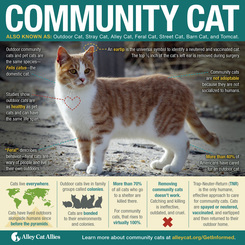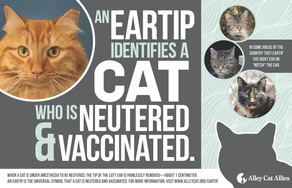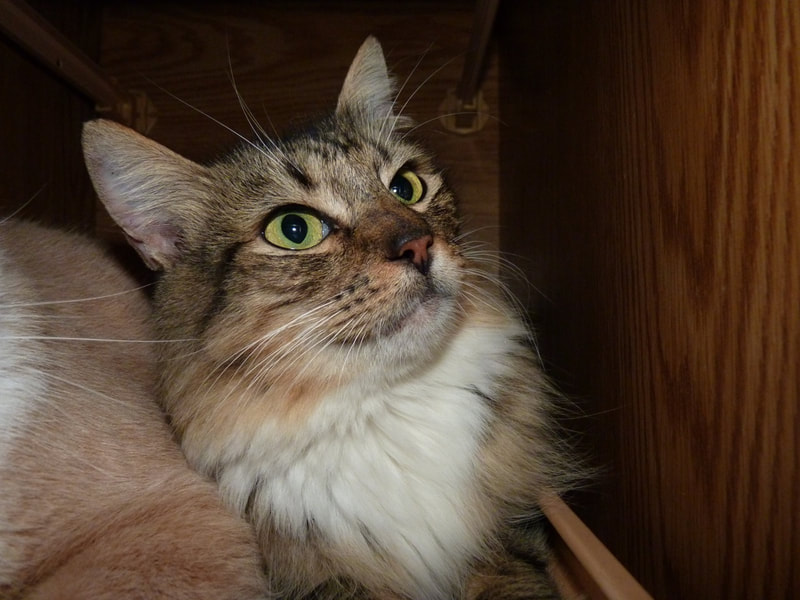 click image to view .pdf click image to view .pdf National Feral Cat Day is on Sunday, October 16, 2016. As we approach this national day of awareness and education, I wanted to blog about the topic of community cats. I know I tend to talk about dogs more than cats on my website simply due to my volunteer work for certain nonprofit organizations which help dogs, but the issue of community cats is one I deal with on a regular basis because of the managed colony of community cats where I work. What is a Community Cat? A community cat is a cat who lives outside. These cats are also known of as outdoor cats, stray cats, alley cats, feral cats, street cats, barn cats and tomcats. They originate from former domestic cats who were lost or abandoned and then learned to live outdoors or in environments involving little human contact, such as warehouses, factories or abandoned buildings. Outdoor cats live in family groups called colonies. They are bonded to their environments due to the resources they find there: food, water and shelter. They are also bonded to each other for companionship and protection. What is a Feral Cat? A feral cat is a community cat but not all community cats are feral. A feral cat is one who is not socialized to humans. You can often tell the difference between feral cat and a cat who is social to humans through body language and behavior. A stray cat which may be social to people will often approach people, houses, porches and cars. A feral cat will not approach people and will seek out places to hide. A stray cat might walk or move much like a house cat with his or her tail in the air. A feral cat may crawl, crouch or stay low to the ground and protect his or her body with the tail. A stray cat may look at you, blink, make eye contact or even vocalize near you. A feral cat is unlikely to make eye contact or vocalize at all.  click image to view .pdf click image to view .pdf Shouldn’t We Just Destroy These Cats? Some people would argue that community cats should be destroyed in order to remove them from the ecosystem or to prevent them from destroying birds. Free-roaming cats live in certain areas because of the resources available there. If you destroy the cats, more will simply take their place. This is called “the vacuum effect.” The arguments that feral cats destroy wildlife or spread rabies are myths. Habitat destruction and pesticides are the main cause of diminishing wildlife. According to Alley Cat Allies, the last confirmed cat to human transmission of rabies occurred more than 40 years ago. Outdoor cats are as healthy and pet cats and can have the same life span. In stark contrast, more than 70% of cats who end up in shelters nationally are destroyed. When it comes to community cats, that number rises to 100% in all but the most progressive communities. A national survey conducted by Alley Cat Allies showed that more than 80% of Americans believe that leaving a stray cat outside to live out his or her life is more humane than having the cat caught and killed. More than 40% of Americans have cared for an outdoor cat; it is clear that Americans want compassionate approaches for cats. How Do We Help These Cats? Studies have shown that Trap-Neuter-Return - TNR - is the only method proven to be humane and effective at controlling community cat population growth. Using this technique, all the cats in a colony are trapped, neutered (or spayed), vaccinated and then returned to their territory where caretakers provide them with regular food and shelter. It is customary to “ear tip” the left ear of the cat during surgery so the cat be easily identified as a cat who has been sterilized and vaccinated. Young kittens and friendly adults trapped in TNR are placed in foster care and eventually adopted out to good homes. TNR stabilizes the size of the colony by eliminating new litters. The nuisance behavior often associated with feral cats is also dramatically reduced, including the yowling and fighting that come with mating activity and the odor of un-neutered males spraying to mark their territory. What Are Some of the Indirect Benefits of TNR? In addition to helping cats who live outside, another significant advantage to TNR is that it lessens the number of kittens and cats flowing into local shelters. It is more humane and cost-effective to use TNR to control cat populations so that tax-dollars are not needlessly spent on what is sometimes referred to as a "catch and kill" method of handling free-roaming cats. Another indirect benefit of TNR is what cats who are social to humans, but who are just lost, scared or injured, are helped in the process. A cat who is outside and who needs help is often hard to distinguish from a feral cat. It is only in the process of doing TNR that rescuers and people who help cat colonies are able to help cats who require veterinary care or who are completely social to humans and just need a new home. Why Would Anyone Oppose TNR? The topic of feral cats is one which is the subject of a lot of controversy nationally. In spite of numerous studies to the contrary, there are those who are simply convinced that free roaming cats are a danger to wildlife, they harm the environment and they should just be destroyed. I simply could not agree more. I will leave it up to organizations like Alley Cat Allies to fend off the blows of the cat haters with science. For me, this is just a simple issue: TNR works.  My Personal TNR Story. I work at an office building in a centrally located area of a fairly large city, next to the major thoroughfare which runs through the city from north to south. We have been doing TNR of community cats for years with the help of a local rescue group called Forgotten Felines. I know for a fact that in the years we have been doing TNR, 90% of the cats we have helped were actually social to people and were not feral at all. Many of them acted unsocial at first, but once they were trapped and helped, we found that they actually seemed relieved to be safe and in the company of people. Yes, some of our cats really are feral and they live outside in our managed colony, moving between parcels primarily through the street drainage system. They are fed once a day 365 days a year, we monitor their health by observing them and I dare to say they have it pretty good between nutritious food and some cat houses which are actually insulated with spray foam. For those who oppose TNR, saying it is cruel or not effective, I say this: if you really care about the welfare of cats, you simply cannot discount the fact that TNR reduces cat populations, keeps kittens from being born and helps pet cats who are social to people. We have helped cats who were so thin they were on death’s doorstep. We had one cat with multiple broken bones in her front left arm that had to be treated by an orthopedic surgeon. Still other cats have had infections which gone untreated may have killed them. But for us doing TNR and helping the cats who make their way to one of our feeding stations, they would have died and in many cases their death would be slow and painful. And but for us doing TNR and helping cats here, they would likely have ended up in our municipal animal shelter where they would have been destroyed using tax dollars. If your cat was lost or went missing, you would want someone doing TNR to help him or her.
2 Comments
Paws4Change
10/11/2016 07:39:16 am
Karen, your best bet is to find a rescue group who can handle this for you. They will know how to trap and may be able to place the kittens. Here is a link you can use to find a group near you. I wish you all the best!
Reply
Your comment will be posted after it is approved.
Leave a Reply. |
AuthorI am an animal welfare advocate. My goal is to help people understand some basic issues related to companion animals in America. Awareness leads to education leads to action leads to change. Archives
July 2024
Categories
All
image courtesy of Terrah Johnson
|
 RSS Feed
RSS Feed